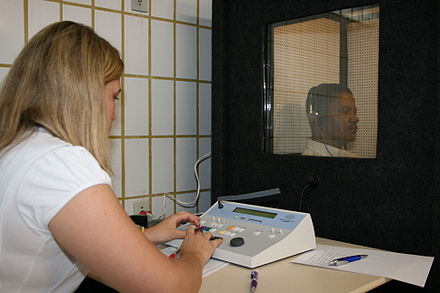Facts About Hearing Loss

Hearing Loss
Hearing loss is a common problem, which occurs for a variety of reasons. Some reasons for hearing loss include; age, disease, long term exposure to loud noise and heredity. It can be difficult to have a conversation with family, friends, doctors and it can be difficult to hear alarms or doorbells with hearing loss. Excessive earwax can temporarily reduce hearing. Unfortunately, most hearing loss is not reversible.
Ear Anatomy
There are three parts to the ear. outer, middle and inner ear.
The outer ear consists of:
- Pinna - the area we see
- Ear canal
- Eardrum - tympanic membrane separating the pinna and ear canal
The middle ear consists of:
- Eardrum
- Ossicles - three small bones sending the movement of the eardrum to the inner ear
The inner ear consists of:
- Cochlea - snail shaped organ for hearing
- Semicircular canals aiding balance
- Nerves from the inner that send sound information to the brain

How the Ear Works
When sound waves reach the eardrum via the ear canal it then vibrates. The sound waves are transferred by the middle ear’s tiny bones to the fluid filled inner ear. The fluid moves the hair cells that generate nerve impulses that are then taken to the brain by the cochlear nerve. The temporal lobe of the brain interprets the impulses as sound.
Hearing Loss
Presbycusis hearing loss is common, and it is a gradual loss that occurs with aging. In the U.S. approximately one-third of the population have some degree of hearing loss between the ages of 65 and 75, which jumps to one half of the people over 75 years of age. There are an estimated 466 million people worldwide with hearing loss.
There are four types of hearing loss, and they are defined as:
- Conductive - involves the middle or outer ear
- Sensorineural - involving the inner ear
- Mixed loss is a combination of conductive and sensorineural
- Auditory Neuropathy Spectrum Disorder
The degree of hearing loss may be mild, moderate, severe or profound. A person with severe hearing loss will hear very little speech and only loud sounds. A person with profound hearing loss will not hear any speech.
Conductive Hearing Loss
Sensorineural Hearing Loss
Hearing Loss Symptoms
There are several signs and symptoms of hearing loss, which include:
- Difficulty in understanding words, particularly with background noise
- Trouble in hearing consonants
- Muffling of speech and other sounds
- Asking other people to speak up or more clearly
- Withdrawal from conversations or avoidance of some social settings
- Needing to turn up the volume on the radio or television
Diagnosis of Hearing Loss
There are several ways a physician will diagnose hearing loss, including:
- Physical examination to look for infection, excess earwax or structural issues
- A doctor may use the whisper test where one ear is covered and words are spoken at different levels
- Audiometer tests where an audiologist has you wear headphones and sounds are directed to both ears at various levels
- Tuning fork tests

Tinnitus
Tinnitus is a perception of ringing or noise in the ears that affects 15% to 20% of people, which is a symptom of an underlying condition. Tinnitus can be a ringing, buzzing, roaring, clicking, hissing or humming in the ears. Subjective tinnitus is a noise that only you can hear and objective tinnitus is a noise that your doctor can also hear, which is rare. A common cause of tinnitus is inner ear hair cell damage. This condition is common with age related hearing loss. There are numerous other causes and no cure for this condition unless it is caused by earwax blockage.
Treatment for Hearing Loss
Treatments for hearing loss are limited with hearing aids being the most common successful option. Many people do not like using hearing aids, but often they are the best option for improving a person’s quality of hearing.
Treatments include:
- Ear wax can be removed with suction or a small tool
- Surgical procedures that vary according to the cause of the hearing loss
- Hearing aids
- Cochlear implants for severe loss which amplifies sound and directs it into the ear canal. This will bypass damage or nonworking parts of the inner ear.
Hearing aids typically use the same basic parts to carry sounds into the inner ear to make them louder. Most of them are digital and have a battery. Hearing aids collect sounds from the environment and a computer chip amplifies that sound and converts them into a digital code to make them louder. These amplified sound waves are then delivered into sound waves and delivered to your eas through speakers.
Final Thoughts
Hearing loss is an issue many of us deal with, especially as we age. There are numerous reasons for hearing loss, but aging is the number one reason. There are some ways to help with hearing loss, but using a hearing aide is the number one aid for this problem.
References
- https://www.nia.nih.gov/health/hearing-loss-common-problem-older-adults
- https://www.asha.org/public/hearing/Types-of-Hearing-Loss/
- https://www.mayoclinic.org/diseases-conditions/hearing-loss/symptoms-causes/syc-20373072
- https://www.mayoclinic.org/diseases-conditions/hearing-loss/diagnosis-treatment/drc-20373077
- https://www.cdc.gov/ncbddd/hearingloss/types.html
- https://en.wikipedia.org/wiki/Hearing_loss
- https://www.mayoclinic.org/diseases-c
This content is accurate and true to the best of the author’s knowledge and does not substitute for diagnosis, prognosis, treatment, prescription, and/or dietary advice from a licensed health professional. Drugs, supplements, and natural remedies may have dangerous side effects. If pregnant or nursing, consult with a qualified provider on an individual basis. Seek immediate help if you are experiencing a medical emergency.
© 2020 Pamela Oglesby








